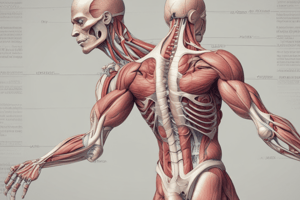Podcast
Questions and Answers
What are the three main groups of back muscles?
What are the three main groups of back muscles?
Superficial, intermediate, and deep muscles.
Describe the primary function of the trapezius muscle.
Describe the primary function of the trapezius muscle.
It elevates, retracts, and rotates the scapula while also extending the neck.
What role does the latissimus dorsi muscle play in arm movement?
What role does the latissimus dorsi muscle play in arm movement?
It extends, adducts, and medially rotates the arm.
How do the serraus posterior superior and inferior muscles contribute to respiration?
How do the serraus posterior superior and inferior muscles contribute to respiration?
What are the primary functions of the erector spinae group?
What are the primary functions of the erector spinae group?
Identify the primary innervation source for the back muscles.
Identify the primary innervation source for the back muscles.
Which arteries primarily supply blood to the muscles of the back?
Which arteries primarily supply blood to the muscles of the back?
What is the significance of strength and flexibility exercises for back muscles?
What is the significance of strength and flexibility exercises for back muscles?
Flashcards are hidden until you start studying
Study Notes
Anatomy: Muscles of the Back
1. Overview
- Muscles of the back are primarily responsible for movement, stability, and posture.
- They are categorized into three main groups: superficial, intermediate, and deep muscles.
2. Superficial Back Muscles
- Trapezius
- Shape: Diamond or kite-shaped
- Functions: Elevates, retracts, and rotates scapula; extends neck.
- Latissimus Dorsi
- Shape: Broad, flat muscle.
- Functions: Extends, adducts, and medially rotates the arm; assists in trunk movement.
- Rhomboid Major and Minor
- Location: Between the spine and scapula.
- Functions: Retracts and elevates scapula.
3. Intermediate Back Muscles
- Serratus Posterior Superior
- Location: Upper back.
- Functions: Elevates ribs during inhalation.
- Serratus Posterior Inferior
- Location: Lower back.
- Functions: Depresses ribs during exhalation.
4. Deep Back Muscles
- Erector Spinae Group (Iliocostalis, Longissimus, Spinalis)
- Functions: Extends and laterally flexes the vertebral column; supports upright posture.
- Transversospinalis Group (Semispinalis, Multifidus, Rotatores)
- Functions: Stabilizes and rotates the vertebral column; aids in extension.
5. Muscle Innervation
- Primarily innervated by the dorsal rami of spinal nerves.
- Superficial muscles may receive innervation from cranial and cervical nerves.
6. Blood Supply
- Supplied by branches of the posterior intercostal arteries, lumbar arteries, and the subclavian artery.
7. Clinical Relevance
- Back muscles can be affected by strain, injury, or conditions like scoliosis.
- Strength and flexibility exercises are crucial for back health and injury prevention.
Overview of Back Muscles
- Back muscles play a vital role in movement, stability, and maintaining posture.
- Three primary categories: superficial, intermediate, and deep muscles.
Superficial Back Muscles
- Trapezius
- Shape resembles a diamond or kite.
- Functions include elevating, retracting, and rotating the scapula, as well as extending the neck.
- Latissimus Dorsi
- Characterized as a broad, flat muscle.
- Responsible for extending, adducting, and medially rotating the arm; aids in trunk movement.
- Rhomboid Major and Minor
- Positioned between the spine and the scapula.
- Primarily retracts and elevates the scapula.
Intermediate Back Muscles
- Serratus Posterior Superior
- Located in the upper back region.
- Elevates ribs during inhalation.
- Serratus Posterior Inferior
- Found in the lower back area.
- Functions to depress ribs during exhalation.
Deep Back Muscles
- Erector Spinae Group (including Iliocostalis, Longissimus, Spinalis)
- Responsible for extending and laterally flexing the vertebral column; crucial for supporting an upright posture.
- Transversospinalis Group (comprising Semispinalis, Multifidus, Rotatores)
- Stabilizes and rotates the vertebral column; aids in extension.
Muscle Innervation
- Dorsal rami of spinal nerves primarily provide innervation to back muscles.
- Superficial muscles may receive some innervation from cranial and cervical nerves.
Blood Supply
- Back muscles receive blood from branches of the posterior intercostal arteries, lumbar arteries, and subclavian artery.
Clinical Relevance
- Back muscles are susceptible to strain, injury, and conditions such as scoliosis.
- Engaging in strength and flexibility exercises is essential for maintaining back health and preventing injuries.
Studying That Suits You
Use AI to generate personalized quizzes and flashcards to suit your learning preferences.




